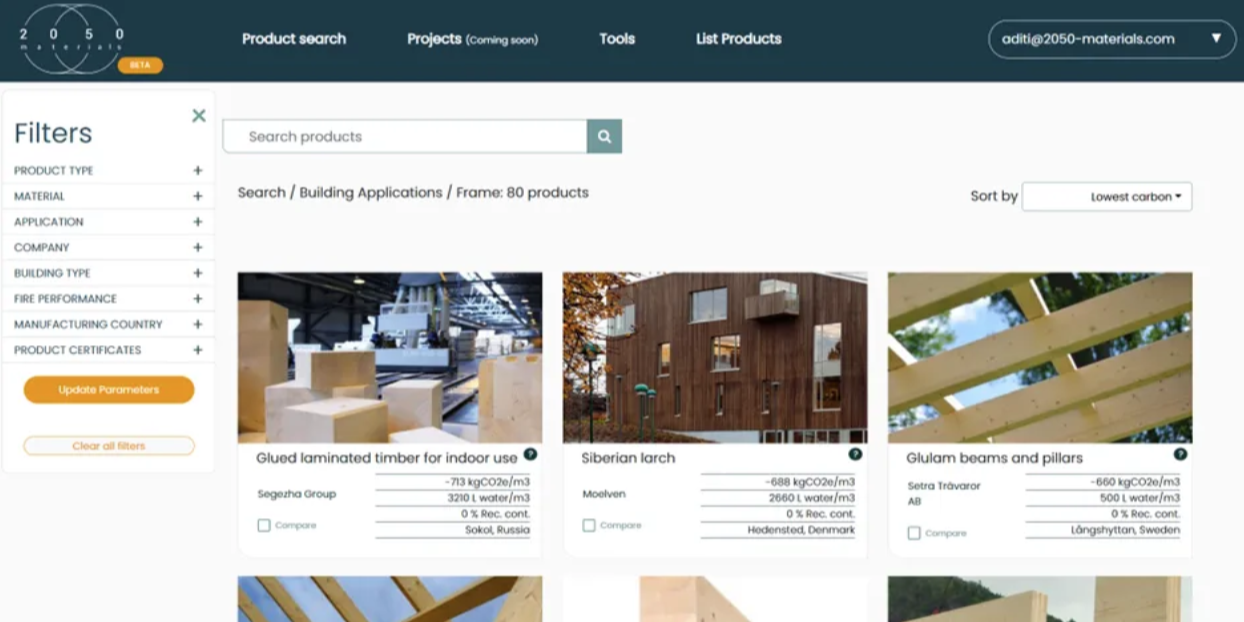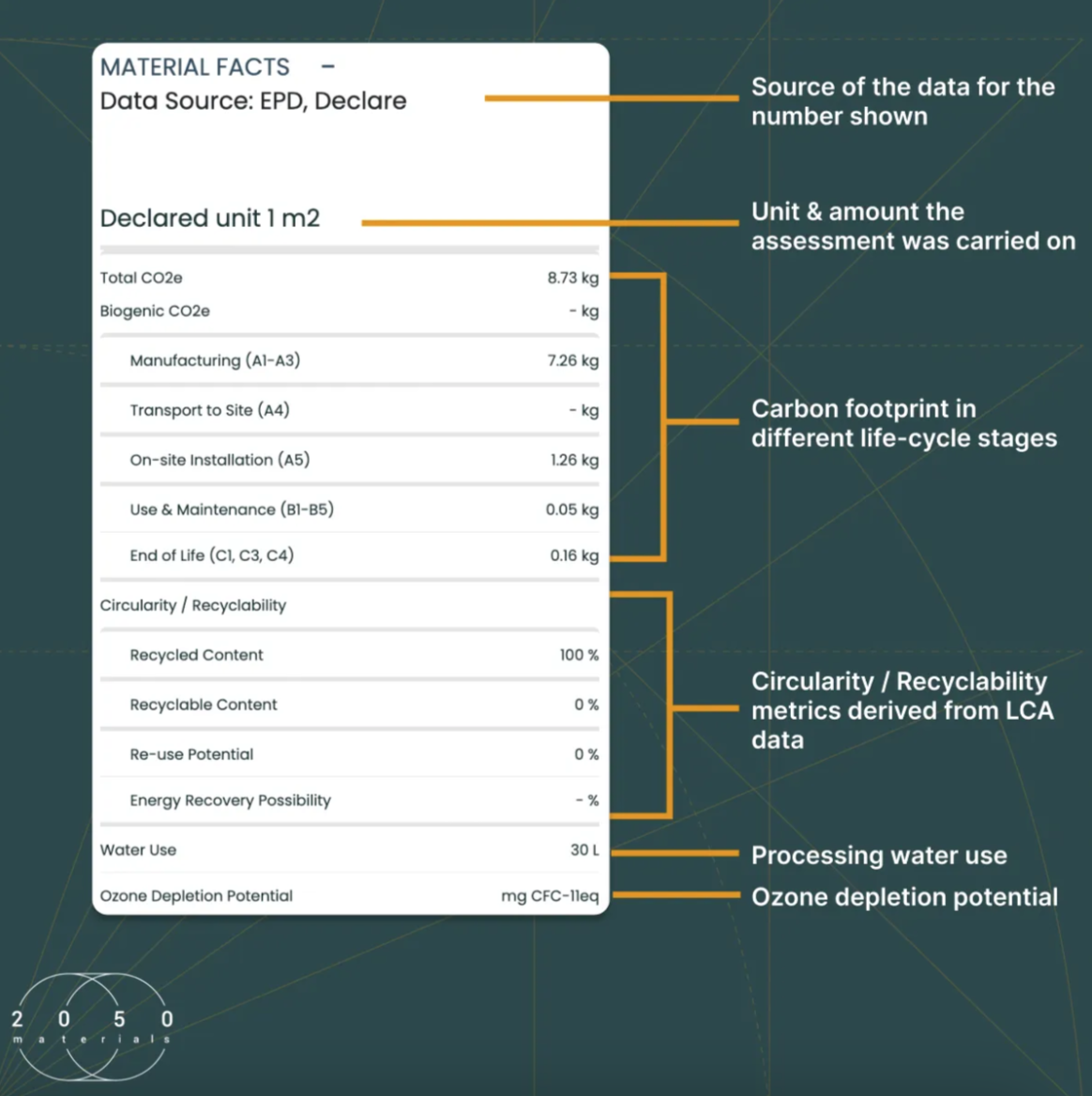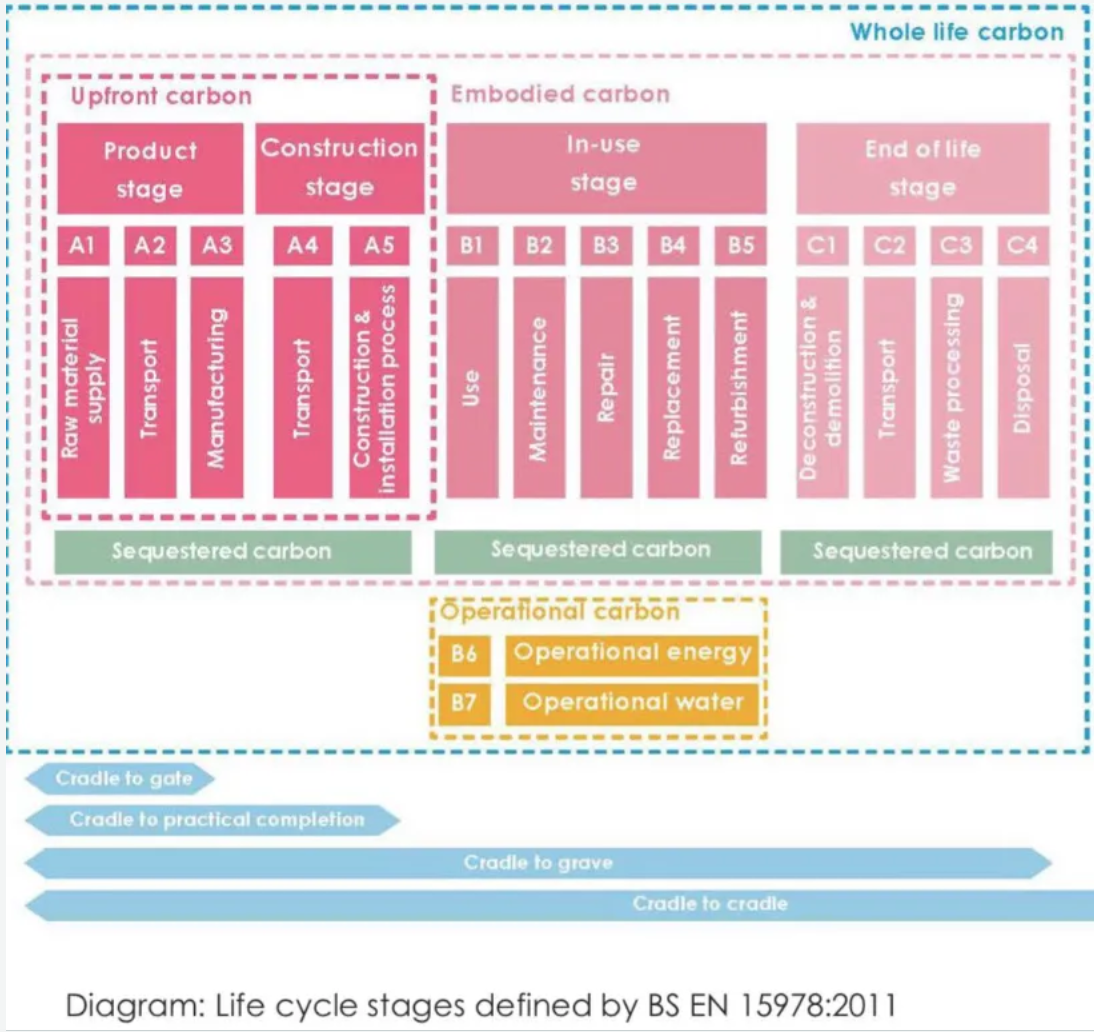2050 Material facts – What and Why
In the process of democratizing sustainable construction, we provide environmental impact assessment data of the products listed on our platform to our audience/users in a concise and easy to comprehend manner.
The assessed data is presented in the material facts’ section and helps in ease of comparison of different products listed and in understanding the impact of each product while making an informed choice in designing and building towards a sustainable future.

Sustainability data at a glance
What are material facts?
The material facts’ section provides a comprehensive information on a product’s environmental impact basis indicators and metrics including carbon footprint ( GWP), freshwater use (FW), ozone depletion potential (ODP), circularity, and recyclability potential.

What is the declared unit?
Declared or functional unit of the product is the unit used for measurement of the impact of the product. It is the unit per which the assessment results are calculated. Declared or functional unit is expressed in units including kg, m2, m3, or per piece of the product.
Different components of material facts:
Carbon footprint — refers to and includes all greenhouse gas emissions. GWP; Global warming Potential of emissions is computed in units of CO2 equivalent. Assessment includes manufacturing, transport to site, on-site installation carbon, use and maintenance carbon, end of life carbon.
Water footprint — the water component refers to the net freshwater use for the cradle to gate lifecycle stages of the product.
Circularity and recyclability — the circularity and recyclability component of the material facts’ section comprises recycled content, recyclable content, reuse potential and energy recovery potential. These refer to the reuse, recovery and recycling potential of the product and also help us understand the amount of the product that is derived from virgin materials and with the use of non-renewable energy.
Lifecycle stages:

Source: LETI Embodied Carbon Primer, supplementary guidance to the Climate Emergency Design guide; https://www.leti.london/_files/ugd/252d09_8ceffcbcafdb43cf8a19ab9af5073b92.pdf
The material facts for each component of a product, we take into account primarily the cradle to gate lifecycle stages that include raw material extraction (A1) , transport to the manufacturing location (A2) and manufacturing (A3) stages of environmental impact, waste, and resource use. Transportation, use and end of life stages of all components are also important in understanding the whole life cycle impact of the product.
The material facts’ section also includes the environmental impact of the construction installation stage (A5), use stage (B1-B5) and end-of-life stage (C1, C3, C4) of the product.
Why are A4 and C2 stages excluded?
Due to lack of accuracy of data, stages A4 ( Transport to site) and C2 (Transport — end-of-life) data are excluded from our calculations and assessment.
Where is the data sourced from?

The data is sourced from Environmental Product Declaration (EPDs) that are standardized documents and are listed by the manufacturers. The relevant components of the data that we use from the EPDs in our material facts’s section is as given in the table above. It includes the environmental impact, resource use, water use and circularity/recyclability parameters.The data source of the products is mentioned on our platform and is in line with our transparency commitment.
How is the recyclability data computed?
Recycled content = (Secondary Material) / (Weight of the functional unit)
Recyclable content = (Materials for recycling) / (Weight of the functional unit)
Reuse potential = (Components for reuse) / (Weight of the functional unit)
Energy recovery potential = ( Materials for energy recovery) / (Weight of the functional unit)
What are the benefits of the material facts section?
1. Holistic sustainability data available at a glance
Our holistic approach to sustainability implies a comprehensive presentation of data on different indicators and parameters that measure the impact of the product.
2. Aids comparison of different products along with their impact assessment
The available sustainability data helps in the ease of comparison of different products’ performance on basic social and environmental impact indicators. The comparison section also allows us to view the different certifications and datasheets available for the products along with the technical specifications provided by the manufacturer. For some, a price rating is also accessible to compare theoretically exchangeable products within a category.
3. Helps in making informed choices in material selection
Designers, specifiers, and architects can make use of the relevant data in the design process to reduce the impact of a project with the help of the easily accessible and comprehensible data that does not require a deep understanding of sustainability metrics.
4. Promotes transparent manufacturing and construction processes
The sustainability information of the products listed on the platform includes the impact associated with the products’ manufacturing and construction processes. It is aligned with our objective of promoting transparency which is essential towards creating an opportunity for people to make better informed choices.
5. Simplifies selection of sustainable building materials
Easily accessible and comprehensible information on alternative materials can be applied to projects by designers and architects and with their informed choices in material selection, a transition to a sustainable built environment can be facilitated.
For any questions or suggestions to help us improve our approach, reach out to us at info@2050-materials.com
The 2050 Materials team
Related articles

Climate-Resilient Materials for the Built Environment: A Data-Centred Prime
As climate volatility intensifies, resilience metrics are fast becoming as critical as carbon data in material selection. This article outlines why adaptation is now a design imperative, how materials can be evaluated through a systems lens, and what KPIs project teams should demand. From self-healing concrete to fire-rated façades, we present a structured taxonomy of resilient materials, explain how to embed this intelligence into digital design workflows, and propose next steps for specification, benchmarking, and procurement.
Read more
The Most Interesting Low Carbon Products in Office Design
In this article and collection, we highlight 11 outstanding products that contribute to a lower carbon footprint in office design.
Read more
Top Low Carbon Building Boards: Performance, Benefits, and Use Cases
The building boards highlighted in this article and collection showcase low-carbon innovation in modern construction.
Read more